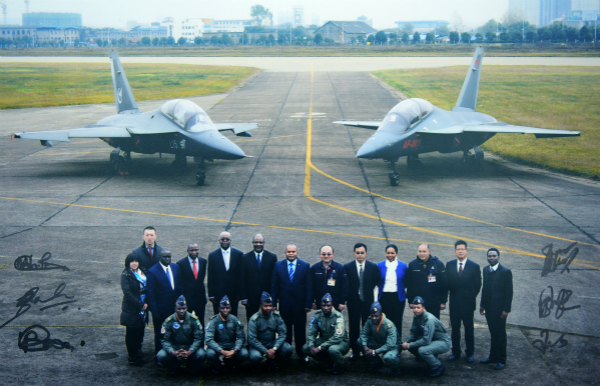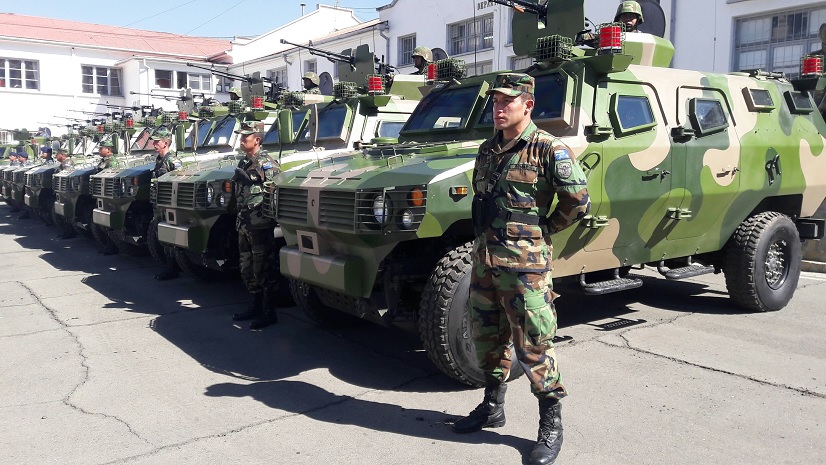I think the Pakistan case in article wasn't very good example.
Russia didn't expect to sale big amount of advance weapons to Pakistan anyway since doing that may impact their relationship with India, which is their biggest client.
Rise of the clones: Chinese knockoffs undercut Russian arms exports
August 11, 2015 Rakesh Krishnan Simha, special to RBTH
Moscow is taking a calculated gamble that the strategic benefits of exporting weapons to Beijing will outweigh the risk of Chinese copying.
- http://asia.rbth.com/blogs/2015/08/11/rise_of_the_clones_chinese_knockoffs_undercut_russian_arms_exports_48345.html
Defence exports to China provide Russia with a bunch of strategic benefits.
Besides bringing in bucket loads of quick cash, Russian weapons generate
a strategic spinoff by counterbalancing US military power in Asia.
Beijing’s insatiable appetite for advanced weaponry keeps the Russian defence industry ticking along nicely
and forces the Americans to divert substantial offensive and defensive resources to check China.
This reduces pressure on Russia’s European flanks.
However, Russian arms exports to China come with a major downside.
The Chinese often buy limited quantities or ‘samples’, take them apart, and then reverse engineer the weapons.
These knock-offs are then peddled cheap as chips overseas, undercutting Russian exports.
As the Chinese defence industry grows in sophistication, Moscow sees its market share under threat.
In the arms trade, everyone is a copycat.
The Russians reverse engineered the B-29 bomber and produced the Tu-4, which was hard to tell apart from the American original.
The Germans copied the sloping armour of Russia’s T-34, the finest tank of WWII.
Early American missiles were copies of Germany’s V-2 rockets that had flattened London.
But the Chinese have taken reverse engineering to a different level.
They have copied the German Maglev train and are now offering it to India.
Their hackers stole the blueprints of France’s TGV.
Chinese J-20 and J-30 stealth fighters are based on technology purloined from American companies that developed the F-35 and F-22.
Virtually every missile, tank, artillery system and gun used by the Chinese military is a knockoff of a Russian original.
Take the legendary AK-47 assault rifle.
During the bonhomie of the 1950s, the Russians allowed the Chinese to build a local version,
but after the licensing agreement ended, Beijing – like Hungary, Slovakia and the US among others – started producing illegal AKs.
While the original Russian rifle can cost up to $1500 on the US market, a Chinese version can be bought for $400.
Fake Flankers
Cheap Kalashnikov knockoffs were, however, the least of Moscow’s worries.
For, the Chinese had graduated to clone the crown jewels of Russia’s defence export sector such as the Su-27 Flanker fighter bomber,
the aircraft carrier-based Su-33 jet, S-300 air defence system, and the popular Smerch anti-aircraft system.
Interestingly, Russia hadn’t exported the Su-33 or the Smerch to China;
Beijing had acquired them on the sly from third parties such as perennially troublesome Ukraine.
The Chinese, on the other hand, deny they copy foreign technology.
Whether it is the Maglev, TGV or Flankers, they claim to have made considerable improvements to the original basic design and hardware.
China's spokesman of the Ministry of National Defense, Geng Yansheng, responded to these allegations in November of 2012, saying,
“The world’s military affairs have an objective law of development.
Many weapons have the same design principle and some command and protection methods are also similar.
Therefore, it is non-professional to conclude that China copied the aircraft carrier technology of other countries only by simply comparison.”
But experts disagree. There is no doubt the J11B and J15 fighters are clones of the Su-27 and Su-33 respectively.
According to Flight Global, the Chinese do not understand – or care about – the concept of intellectual property.
“All the Chinese have done is performed what amounts to a mid-life update to the reverse engineered Su-33 design,
but the airframe, at its core, remains a Flanker.
Simply upgrading a design after stealing the intellectual property does not make an original design,” it says.
Implications for Russia
After reverse engineering for decades, China is now in a position to encroach upon Russia's traditional export markets.
And like Russia, which sweetens big-ticket defence deal with soft loans,
China can use its massive stockpile of export earnings to offer even better terms to cash-poor nations such as Pakistan.
“The result is not only decreasing sales from Russia to China,
but Russia also loses sales to other countries that are now buying Chinese produced weapons,”
say Nikolas Gvosdev and Christopher Marsh in Russian Foreign Policy: Interests, Vectors and Sectors.
“This leaves Russia bitter not only about China's illegal copying of Russia's military technology
but also over the loss of sales of those weapons to third countries.
Russia is faced with a dilemma: It can sit back and take the hit,
or it can sell even more advanced weaponry to the Chinese to make up for the sales shortfall
(and risk that they will copy those designs too and then export them).”
In fact, the Chinese are beginning to sound increasingly confident – or brazen.
In May, China’s state-owned Norinco, which makes the VT-4 tank,
took aim at the T-14 Armata, the new Russian tank described as revolutionary by arms experts worldwide.
Posting on Norinco’s official social media account, the Chinese company wrote:
“The T-14’s transmission is not well-developed,
as we saw through a malfunction taking place during a rehearsal before the May 9 parade.
The VT-4 has never encountered such problems so far.
Our tanks also have world-class fire-control systems, which the Russians are still trying to catch up with.”
Russia needs to export
The former Soviet Union’s defence industry was of such a gargantuan scale that Russia simply could not sustain all of it.
Even today’s much reduced Russian defence sector – albeit larger than the combined defence industries of China and India – cannot survive for long without export orders.
“Russia needs to sell weapons to keep its military employees working (to help generate high-tech manufacturing employment)
to generate revenue to use in defence R&D, and to generate seed funds for its next generation of military technology.
So Russia must sell its weapons, and China is the biggest potential market out there,” Gvosdev and Marsh explain.
There’s nothing with such a policy.
Following the demise of the Soviet Union it was the new Chinese market that proved to be a lifeline.
In 1993, Russian defence industries were operating at just 10 per cent of their capacity,
says Andrew T.H. Tan in The Global Arms Trade: A Handbook. “Half the defence firms were close due to bankruptcy,” Tan says.
International orders were not being fulfilled – because of the disruption of the supply chain that ran through the various ethnic republics – or had dried up.
The Chinese monetary transfusion was essential for these industries to survive and revive.
Tan points out that during that decade China alone provided half of all sales income for the Russian defence sector.
Therefore, arms sales to China cannot be said to be suicidal for Russia.
Also, with India – once almost completely dependent on Russian weapons – now buying multi-billion dollar platforms
from American defence majors – as a way to improve strategic ties with the US – Moscow is making every sale count.
Building trust
According to Tan, since 2002 both Russia and China have tried to overcome the trust deficit
in order to move their arms business to a new stage of development.
“One major bilateral initiative is to sign an intellectual property agreement as part of a regulatory regime
to safeguard Russia's interests and narrow the grey areas in technological transfers.
“For instance, when China acquired the production licence to assemble Su-27s,
it was not clarified whether the aircraft engines that China would produce under the agreement could be used for other Chinese aircraft,
still less, for Chinese export of its aircraft with the engines produced under the licence.
This has been a persistent dispute in the Sino-Russian arms trade.
“In December 2008 the two countries finally signed an intellectual property rights agreement
that imposes restrictions on Beijing's export of arms originating from Russian models, but does not prevent China from producing them for its own use.
This agreement has lessened Russia's concerns that potentially China may copy Russian weapons without prior Russian consent
and Chinese military hardware may flood the global marketplace, eroding Russia's hard won market share.”
The agreement – along with President Vladimir Putin's executive decision – has cleared a major obstacle
to further military cooperation between the two countries.
The Russian side was initially reluctant to sell the latest S-400 air defence systems and the Su-35 multirole fighters.
Beijing apparently was interested in the Su-35’s AL-41 engines, which have a life of 4000 hours
compared with the 1500 hours of the AL-31 engines on the Su-27 and Su-30.
However, the complexity of advanced Russian aircraft engines has proved to be the biggest constraint on Beijing’s copycat industry.
This – along with the inking of stronger intellectual property protection agreements – has reassured Moscow
about proceeding with the sale of advanced weaponry.
Sukhoi’s deputy director Sergey Sergeyev summed it up:
"It’s one thing to make a good quality copy of a spoon, but quite another to make one of an aircraft.”
In 2013, Putin cleared the sale of the S-400 and the Su-35.
These platforms will provide China with the means to take on the American stealth fighters, the F-22 and F-35,
until its own stealth jets come online in the next decade.
Also, facing western economic sanctions, Russia is looking towards China for military micro-electronics
and other cutting-edge technologies in which Moscow lags.
China’s Russia syndrome
While there will always be an element of risk in exporting weapons to China, there is another key advantage that accrues to Moscow.
According to Tan,
“Russia’s influence on China through arms sales is not limited to its control over supply of important parts and hardware.
Every year, the PLA sends up to 800 officers to Russia to study military science and learn how to operate the Russian arms it has bought.
It is logical to assume that some of the PLA trainees would develop pro-Russia sentiments
or a favourable view of the Russian model of military transformation vis-a-vis the West.
This may have fostered a kind of personal affinity of PLA commanders who once studied in Russia.
Generals Liu Huaquing and Cao Gangchun (Defence Minister 2002-07),
who studied in Russia were strong advocates of importing more Russian arms.
Moreover, education experience in Russia has become a useful credential for promotion.”
Arms trade provides the foundation of Russia-China ties in the 21st century. Both countries need each other.
China is still at least two decades behind the West in weapons technology and it can catch up only with Russian assistance.
Russia has got its back covered by China, which is now its go-to partner for cash, markets and diplomatic comfort.
So expect military sales and ties to continue, but with Moscow keeping a close eye on China’s copycats.















